

What Is Code Audit and How Can It Benefit Your Business: Key Steps and Tools






A code audit is a careful review of your software's source code. It helps ensure that your code is clean, secure, and efficient. Maintaining high-quality code is crucial for business success.
According to a 2022 CISQ report, poor software quality costs the U.S. economy approximately $2.41 trillion. One key way to address this issue is through code audits, which enhance security and performance, protect user data, and build trust with your customers.
This blog will explore code audits in-depth, covering their benefits, best practices, tools, and challenges.
When it comes to improving your code, you might hear the terms "code audit" and "code review." While they sound similar, they serve different purposes.
A code audit is a thorough examination of your entire codebase. It looks for security issues, performance problems, and compliance with coding standards. On the other hand, a code review is usually a more informal process where team members check each other's code for mistakes or improvements.
Code audits are comprehensive and often involve automated tools to ensure nothing is missed. In contrast, code reviews are typically done by peers and focus on specific sections of code. Understanding these differences helps you choose the right approach for maintaining high-quality software.
Now that you understand the difference between code audits and code reviews, let's explore the benefits of conducting code audits.
Conducting code audits offers several key benefits that can significantly improve your software and business.
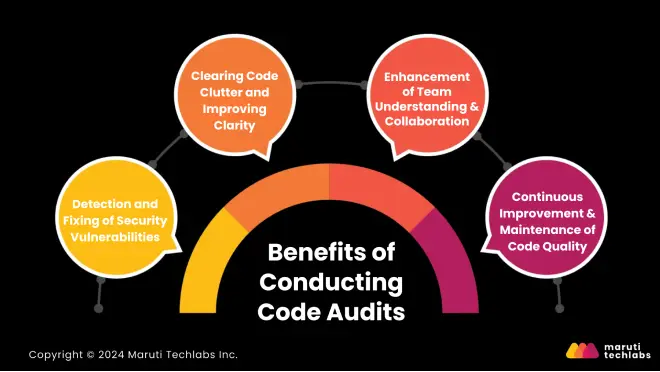
Here are some key advantages:
Code audits help you find security weaknesses before they can be exploited. The 2024 IBM Data Breach Report reveals that data breaches in public clouds had the highest average cost, amounting to USD 5.17 million.
By conducting thorough code audits and addressing vulnerabilities early, you protect both your users and your brand from potential attacks.
Audits help remove unnecessary code, making it easier to read and maintain. This clarity allows your team to work more efficiently. SonarSource says companies change 20% of their code each year to reduce the time spent on troubleshooting and debugging.
When your team participates in audits, they gain a better understanding of the codebase. This shared knowledge fosters collaboration and teamwork and improves overall productivity.
Regular audits promote ongoing improvements in your code quality. They ensure that your software remains efficient and reliable over time. By maintaining high standards, you can enhance user satisfaction and trust in your product.
Having explored the numerous benefits of conducting code audits, it’s clear that these practices can significantly enhance your software quality. Now, let’s dive into the key steps you need to follow to effectively conduct a code audit and maximize these benefits.
Conducting a code audit involves several essential steps that help ensure your software is secure and efficient.
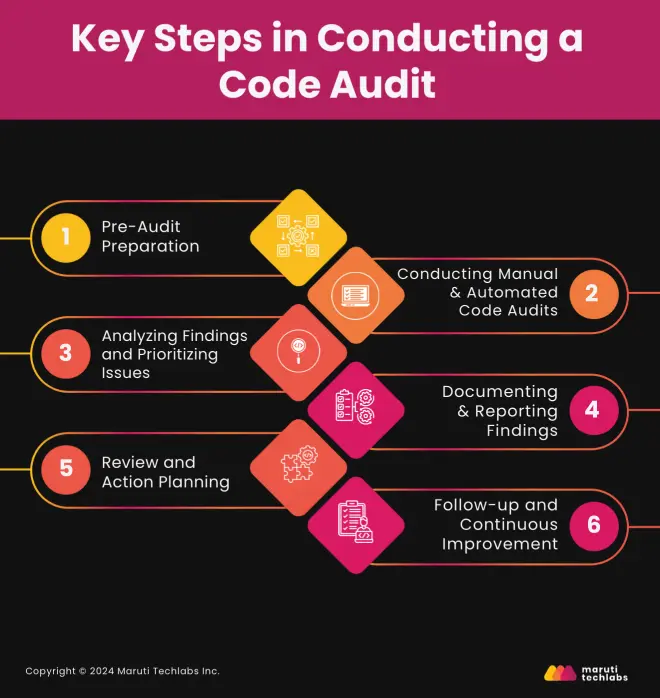
Here's a breakdown of the key steps:
Before starting, set clear objectives for what you want to achieve with the audit. Assemble a skilled audit team with the right expertise. This preparation helps everyone understand their roles and the goals of the audit.
Use manual reviews and automated tools to examine your code. Manual audits allow for a detailed analysis, while automated tools can quickly identify common issues. Combining these methods gives you a thorough understanding of your code's quality.
Once you gather data, analyze the findings to identify critical issues. Prioritize these problems based on their severity and potential impact on your software. This step ensures that you tackle the most crucial problems first.
Clearly document all findings from the audit. Create a report that outlines issues, their severity, and suggested solutions. This documentation serves as a reference for future audits and helps keep everyone informed.
After identifying issues, develop a plan to address them. This action plan should include specific steps, deadlines, and responsible team members to ensure accountability.
Finally, a process for ongoing monitoring and improvements must be established. Regular follow-ups help ensure that issues are resolved and that your code quality continues to improve over time.
By following these steps, you can conduct effective code audits that enhance your software's security and performance.
Having the right tools can make a significant difference as you implement the steps for a successful code audit. Let's explore some effective tools that can enhance your auditing process and ensure your code is secure and high-quality.
Using the right tools can make a big difference in your code audits' effectiveness.
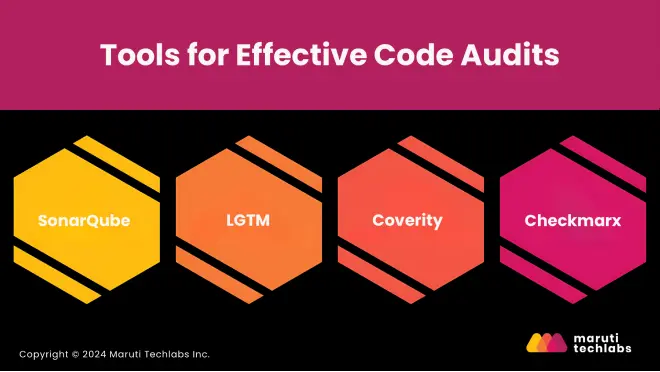
Here are some popular tools that can help you conduct thorough audits:
This tool checks your code for quality and security issues. It scans your codebase and provides detailed reports on bugs, vulnerabilities, and code smells (bad coding practices). By using SonarQube, you can improve the overall health of your code and ensure it meets industry standards.
LGTM stands for "Looks Good To Me." This tool automates code reviews by analyzing your code for potential problems. It helps catch issues early in the development process, saving time and effort later. With LGTM, you can focus on writing better code while it takes care of the review process.
Coverity is known for its ability to identify bugs in your code. It scans your software to find defects that could lead to crashes or security vulnerabilities. By fixing these bugs early, you can enhance the reliability of your software and avoid costly fixes down the line.
This tool specializes in application security testing. Checkmarx scans your code for security vulnerabilities and provides actionable insights on how to fix them. By using Checkmarx, you can ensure that your applications are safe from threats and protect your users' data.
Now that you know about the essential tools for conducting code audits, it’s important to understand how to implement these audits effectively.
To ensure your code audits are effective, following best practices is essential.
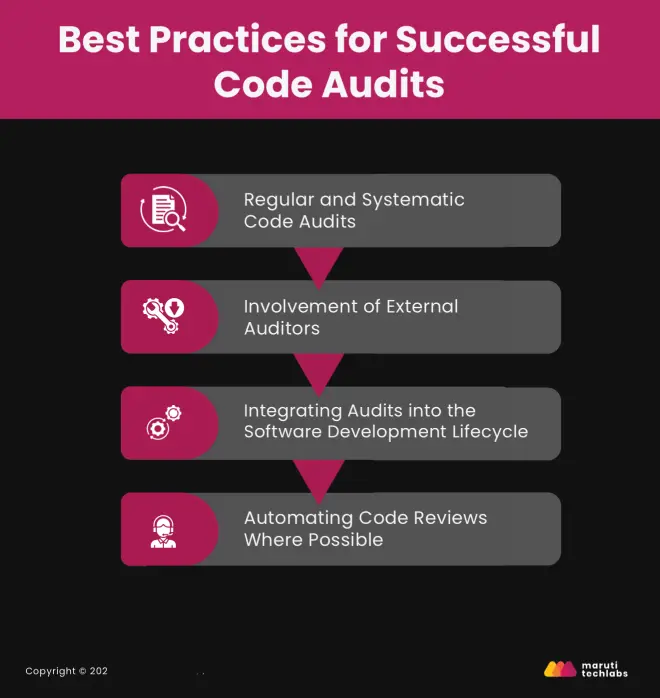
Here are some key strategies to consider:
Conducting audits on a consistent schedule helps catch issues early. Companies like Google prioritize regular audits to maintain high standards in their software. This practice allows them to quickly identify and fix problems, ensuring their products run smoothly and securely.
Engaging outside experts can provide fresh perspectives on your code. Microsoft often brings in external auditors to spot issues that internal teams might miss. This approach improves their code quality and enhances security, leading to more reliable software.
Making audits a part of the development process is crucial. For instance, Amazon integrates audits into its workflow, allowing them to catch issues as they arise. This strategy ensures that quality is prioritized from the start, leading to faster delivery of new features and a better overall product.
Utilizing automated tools for code reviews can streamline the process. Facebook employs automation to quickly identify common issues, allowing developers to focus on more complex problems. This efficiency leads to quicker releases and better software quality.
While implementing best practices can significantly improve your code audit process, it's essential to recognize that challenges still exist. Understanding these challenges will help you navigate potential obstacles and ensure that your audits are effective and beneficial.
Conducting code audits is essential, but it comes with its own set of challenges.
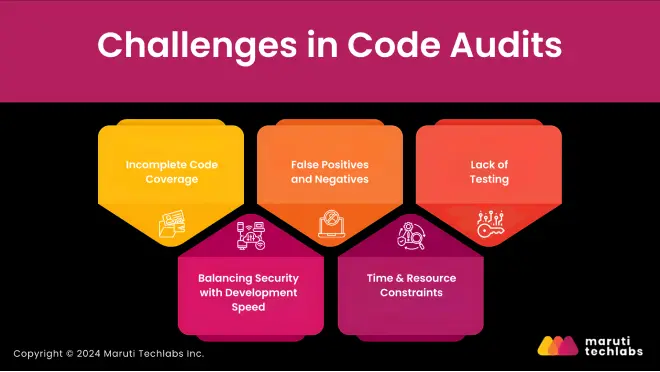
Here are some common obstacles and practical solutions to overcome them:
Sometimes, audits may not cover all parts of the code. This can happen if the audit team overlooks specific files or sections. To solve this, create a checklist that includes all areas of the codebase. Using automated tools can help ensure that every part of the code is reviewed.
Automated tools might flag issues that aren't really problems (false positives) or miss actual problems (false negatives). This can lead to confusion and wasted time. To address this, combine automated reviews with manual checks. This way, you can verify the findings and ensure accuracy.
If the code isn't tested correctly before an audit, it may lead to misleading results. Ensure that thorough testing is done before the audit begins. Implement unit tests and integration tests to catch issues early on.
Developers often feel pressured to release software quickly, which can compromise security. Encourage a culture where security is prioritized alongside speed. Implementing regular security training for developers can help them understand the importance of secure coding practices.
Limited time and resources can hinder the effectiveness of audits. To tackle this, plan audits during less busy periods or allocate specific resources solely for auditing tasks. Automated tools can save time and allow teams to focus on more complex issues.
Addressing these challenges with practical solutions can improve your code audit process and enhance the quality of your software.
Ensuring the quality and security of source code is vital for business success. It protects users and builds trust in a brand. Regular code audits help identify vulnerabilities and improve overall software performance.
Conducting thorough audits, implementing best practices, addressing common challenges such as incomplete coverage, and balancing security with speed is essential for effective auditing. Utilizing tools like SonarQube and Checkmarx can streamline the process and enhance code quality.
Maruti Techlabs offers tailored code audit services designed to elevate software quality and security. By leveraging their expertise, businesses can safeguard their applications and achieve greater success.
Get in touch today to explore how Maruti Techlabs can help enhance your software's reliability and security.
Code audits are beneficial for businesses that rely on software, including tech companies, healthcare, e-commerce platforms, and service providers. They help identify vulnerabilities and improve software quality, ensuring a better user experience and increased trust in the brand.
Teams can ensure thorough audits by using a combination of automated tools and manual reviews. This approach helps catch common and complex issues, leading to more comprehensive insights into code quality and security.
Effective code auditing requires a mix of programming knowledge, attention to detail, and analytical skills. Auditors should be familiar with coding standards, security practices, and the specific technologies used in the project to identify potential issues accurately.
Automated tools streamline the audit process by quickly scanning large codebases for known issues. They save time and allow auditors to focus on more complex problems that require human judgment, improving overall efficiency.
After identifying issues, teams should prioritize them based on severity and impact. A clear action plan should be developed to address these issues promptly, ensuring that necessary fixes are implemented and future vulnerabilities are minimized.


